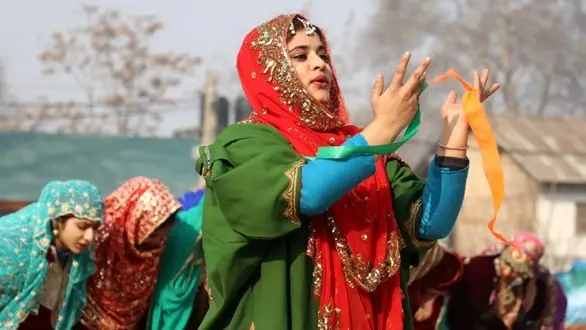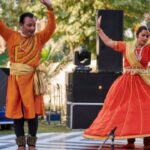The state of Jammu and Kashmir holds a very important value among the lovers of art and culture. Of course most of the people are enthralled with the beauty the state holds, thanks to the wide landscapes and mountains. But beyond this, the state possesses an important cultural and traditional richness. The traditional dance forms of Jammu and Kashmir speak for this long nourished culture.
Dance: An Integral Part of Kashmiri Culture
Dance may dissolve language barriers and link people emotionally. The stunning Kashmir Valley makes it a lifestyle, not simply an art form. Celebrate festivals, marriages, and other cultural occasions with dance. Traditional Jammu & Kashmir dances reflect its diverse culture, spirituality, and history. This gorgeous “Paradise on Earth,” dance has numerous meanings. It maintains traditions, links communities, and stimulates creativity and belonging. Each dance variety reflects the area, from the interesting Rouf dance performed by ladies during harvest celebrations to the mysterious Hafiza dance performed for religious adoration. Jammu and Kashmir’s culture is enriched with charming dances like Bhand Pather, Dumhal, Kud, and Bhagat. These dances transcend performance to show the region’s resilience and passion.
1. Rouf

Rouf is an elegant and culturally important Kashmiri dance. Rouf by women throughout harvest season, especially Baisakhi, captivates audiences. The dancers wear vibrant Kashmiri pherans and flower-adorned headgear to show their culture. Rhythmic footwork and subtle hand motions make it a charming dance. As rice sheaves swirl in the field air, dancers slowly create intricate circular patterns. The generations-old precision and ingenuity fascinate. Rouf’s music improves its appeal. The dance is enhanced by Kashmiri tumbaknari, rabab, and harmonium. The performance had a Kashmiri feel from these instruments. Rouf honors nature and Kashmiris’ deep connection to their land and art. Rouf dances portray Kashmir’s culture, identity, and natural beauty beyond amusement. This mesmerizing dance takes spectators to a world of art, nature, and culture, leaving a lasting impression.
2. Hafiza Dance
Hafiza dance, a Kashmiri secret, is solely done by women. A renowned religious leader is honored in this intriguing dance done at Sufi shrines on auspicious occasions. Traditional-dressed dancers sway to the music with a light. Hafiza dance is spiritual as well as beautiful. This dance supposedly cleanses the soul and summons heaven. Slow movements generate a mystical, spiritual atmosphere. Dance unites artists and viewers spiritually. It caught Kashmiri mysticism, Sufism, and cultural harmony. The dancers’ elegant moves appear to elevate them and their audience. Flashing lamps reflect the soul’s illumination, producing a wonderful radiance.
3. Bhand Pather
Jammu and Kashmiri ethnic dance-drama Bhand Pather captivates. This funny art form has amused and educated the neighborhood on social and cultural concerns for years. The talented “Bhands,” clad in vibrant outfits and painted with exaggerated expressions, are energetic onstage. Bhand Pather’s comedy, drama, and dance demonstrate the region’s rich cultural heritage and creative ability to address social and cultural issues. It mimics society and challenges norms while entertaining and thinking. Bhand Pather’s films help viewers laugh and learn about life, making them a treasure of Jammu and Kashmir’s culture.
4. Dumhal
Dumhal dance is important to Jammu and Kashmir’s Gujjar and Bakarwal communities. Dumhal, performed by men on holidays and other occasions, is breathtaking. The dancers’ extravagant outfits and peacock-feather headdress reflect the region’s vibrant culture. Slow, deliberate movements make Dumhal reverent. In a ceremonial procession led by a skilled drummer, the dancers move in harmony. Performance is engaging because of Dumhal’s choreography. Weddings and other key life events in Gujjar and Bakarwal include the Dumhal dance. Dancers provide a lovely spectacle and foster cultural pride in their communities as they move to the drumbeats. Dumhal is more than entertainment, it embodies Gujjar and Bakarwal tradition, enthusiasm, and togetherness. It creates a sense of family and culture passed down through generations.
5. Kud Dance
Jammu Kud is a Dogra favorite. This vibrant dance style dominates Jammu’s Kud Fair, a major festival. Kud dancers form rows and execute intricate footwork. Traditional Dogra music energizes the colorful dancers. A dhol, nagada, and shehnai rhythm lights up the stage. The Kud dance displays the region’s rich culture and people’s joy. Dancers’ joyous movements create a festive environment. Jammu’s excitement and enthusiasm for life are everywhere. The Kud dance reconnects generations and promotes ethnic pride.
6. Bhagat Dance
Jammu & Kashmir’s Bhagat dance is spiritual. This sacred dance is part of the Bhagat community’s worship to Lord Shiva. This spiritual journey involves saffron-robed dancers carrying a sacred banner. Spirituality and religion underlie Bhagat dance. It shows Bhagat Shiva devotion. Their intricate dances imitate religious narratives and show their devotion. Religious words with dholak and harmonium music accompany the Bhagat dance, which is powerful. Musical rhythms and emotional tunes create an ethereal atmosphere that connects dancers and spectators spiritually. The Bhagat dance brings paradise and spiritual purification, not just entertainment. Elegant movements and intense devotion are considered to cleanse and invoke the divine in Bhagat dancers.
Conclusion
Experience of witnessing any of these dances in the land Jammu and Kashmir is a very important experience. One needs to understand the love the natives of the state have for the dance forms. No matter what the occasions are, these dances are parts and parcel to their life. The art and culture of Jammu and Kashmir thrives thanks to these dances and the dancers who spend their lives with the art form.
Santosh Kumar, the author behind IndiasStuffs.com, is passionate about sharing valuable insights on a variety of topics, including lifestyle, technology, and Indian culture.
Page Contents

